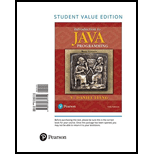
Introduction to Java Programming and Data Structures: Brief Version (11th Global Edition)
11th Edition
ISBN: 9780134671710
Author: Y. Daniel Liang
Publisher: PEARSON
expand_more
expand_more
format_list_bulleted
Question
Chapter 16.3, Problem 16.3.2CP
Program Plan Intro
JavaFX:
Swing is also replaced by a new platform called as JavaFX.
- It integrates a modern GUI technology which permits to develop rich GUI applications.
- JavaFX contains built-in 2D, 3D and animation support.
Button:
A button is defined as a control, which when clicked can trigger an action event
Expert Solution & Answer
Want to see the full answer?
Check out a sample textbook solution
Students have asked these similar questions
using r languange
using r language
show all the work
Chapter 16 Solutions
Introduction to Java Programming and Data Structures: Brief Version (11th Global Edition)
Ch. 16.2 - Prob. 16.2.1CPCh. 16.2 - Prob. 16.2.2CPCh. 16.2 - Prob. 16.2.3CPCh. 16.2 - Prob. 16.2.4CPCh. 16.3 - How do you create a button with a text and a node?...Ch. 16.3 - Prob. 16.3.2CPCh. 16.3 - Prob. 16.3.3CPCh. 16.4 - What is the output of the following code? public...Ch. 16.4 - Prob. 16.4.2CPCh. 16.4 - Prob. 16.4.3CP
Ch. 16.4 - Prob. 16.4.4CPCh. 16.5 - Prob. 16.5.1CPCh. 16.5 - Can you apply all the methods for Labeled to...Ch. 16.5 - Prob. 16.5.3CPCh. 16.5 - Prob. 16.5.4CPCh. 16.6 - Prob. 16.6.1CPCh. 16.6 - Can you apply all the methods for TextInputControl...Ch. 16.6 - Prob. 16.6.3CPCh. 16.6 - Prob. 16.6.4CPCh. 16.7 - Prob. 16.7.1CPCh. 16.7 - Prob. 16.7.2CPCh. 16.7 - Prob. 16.7.3CPCh. 16.7 - Prob. 16.7.4CPCh. 16.8 - Prob. 16.8.1CPCh. 16.8 - Prob. 16.8.2CPCh. 16.8 - Prob. 16.8.3CPCh. 16.8 - Prob. 16.8.4CPCh. 16.9 - Prob. 16.9.1CPCh. 16.9 - Prob. 16.9.2CPCh. 16.9 - Prob. 16.9.3CPCh. 16.9 - How do you obtain the selected items and selected...Ch. 16.10 - Prob. 16.10.1CPCh. 16.10 - Prob. 16.10.2CPCh. 16.10 - Prob. 16.10.3CPCh. 16.11 - Prob. 16.11.1CPCh. 16.11 - Prob. 16.11.2CPCh. 16.11 - Prob. 16.11.3CPCh. 16.12 - Prob. 16.12.1CPCh. 16.12 - Prob. 16.12.2CPCh. 16.12 - How does the program check whether a player wins?...Ch. 16.13 - Prob. 16.13.1CPCh. 16.13 - Prob. 16.13.2CPCh. 16.13 - Prob. 16.13.3CPCh. 16.14 - Prob. 16.14.1CPCh. 16.14 - Prob. 16.14.2CPCh. 16 - Prob. 16.1PECh. 16 - Prob. 16.2PECh. 16 - (Traffic lights) Write a program that simulates a...Ch. 16 - (Create a miles/kilometers converter) Write a...Ch. 16 - (Convert numbers) Write a program that converts...Ch. 16 - (Demonstrate TextField properties) Write a program...Ch. 16 - Prob. 16.7PECh. 16 - (Geometry: two circles intersect?) Write a program...Ch. 16 - (Geometry: two rectangles intersect?) Write a...Ch. 16 - (Text viewer) Write a program that displays a text...Ch. 16 - (Create a histogram for occurrences of letters)...Ch. 16 - Prob. 16.12PECh. 16 - (Compare loans with various interest rates)...Ch. 16 - (Select a font) Write a program that can...Ch. 16 - (Demonstrate Label properties) Write a program to...Ch. 16 - Prob. 16.16PECh. 16 - Prob. 16.17PECh. 16 - (Simulation a running fan) Rewrite Programming...Ch. 16 - Prob. 16.19PECh. 16 - Prob. 16.20PECh. 16 - (Count-down stopwatch) Write a program that allows...Ch. 16 - (Play, loop, and stop a sound clip) Write a...Ch. 16 - (Racing cars) Write a program that simulates four...Ch. 16 - (Slide show) Programming Exercise 15.30 developed...Ch. 16 - Prob. 16.29PECh. 16 - (Pattern recognition: consecutive four equal...Ch. 16 - (Game: connect four) Programming Exercise 8.20...
Knowledge Booster
Similar questions
- show all the workarrow_forwardList down the strenghts and weaknesses of your team project for Capsim Simulation? Explan.arrow_forwardCapsim Team PowerPoint Presentations - Slide Title: Key LearningsWhat were the key learnings that you discovered as a team through your Capsim simulation?arrow_forward
- Write the SQL code that permits to implement the tables: Student and Transcript. NB: Add the constraints on the attributes – keys and other.arrow_forwardDraw an ERD that will involve the entity types: Professor, Student, Department and Course. Be sure to add relationship types, key attributes, attributes and multiplicity on the ERD.arrow_forwardDraw an ERD that represents a book in a library system. Be sure to add relationship types, key attributes, attributes and multiplicity on the ERD.arrow_forward
- 2:21 m Ο 21% AlmaNet WE ARE HIRING Experienced Freshers Salesforce Platform Developer APPLY NOW SEND YOUR CV: Email: hr.almanet@gmail.com Contact: +91 6264643660 Visit: www.almanet.in Locations: India, USA, UK, Vietnam (Remote & Hybrid Options Available)arrow_forwardProvide a detailed explanation of the architecture on the diagramarrow_forwardhello please explain the architecture in the diagram below. thanks youarrow_forward
arrow_back_ios
SEE MORE QUESTIONS
arrow_forward_ios
Recommended textbooks for you
 C++ Programming: From Problem Analysis to Program...Computer ScienceISBN:9781337102087Author:D. S. MalikPublisher:Cengage LearningNp Ms Office 365/Excel 2016 I NtermedComputer ScienceISBN:9781337508841Author:CareyPublisher:Cengage
C++ Programming: From Problem Analysis to Program...Computer ScienceISBN:9781337102087Author:D. S. MalikPublisher:Cengage LearningNp Ms Office 365/Excel 2016 I NtermedComputer ScienceISBN:9781337508841Author:CareyPublisher:Cengage Microsoft Visual C#Computer ScienceISBN:9781337102100Author:Joyce, Farrell.Publisher:Cengage Learning,Programming Logic & Design ComprehensiveComputer ScienceISBN:9781337669405Author:FARRELLPublisher:Cengage
Microsoft Visual C#Computer ScienceISBN:9781337102100Author:Joyce, Farrell.Publisher:Cengage Learning,Programming Logic & Design ComprehensiveComputer ScienceISBN:9781337669405Author:FARRELLPublisher:Cengage EBK JAVA PROGRAMMINGComputer ScienceISBN:9781337671385Author:FARRELLPublisher:CENGAGE LEARNING - CONSIGNMENT
EBK JAVA PROGRAMMINGComputer ScienceISBN:9781337671385Author:FARRELLPublisher:CENGAGE LEARNING - CONSIGNMENT

C++ Programming: From Problem Analysis to Program...
Computer Science
ISBN:9781337102087
Author:D. S. Malik
Publisher:Cengage Learning

Np Ms Office 365/Excel 2016 I Ntermed
Computer Science
ISBN:9781337508841
Author:Carey
Publisher:Cengage


Microsoft Visual C#
Computer Science
ISBN:9781337102100
Author:Joyce, Farrell.
Publisher:Cengage Learning,

Programming Logic & Design Comprehensive
Computer Science
ISBN:9781337669405
Author:FARRELL
Publisher:Cengage

EBK JAVA PROGRAMMING
Computer Science
ISBN:9781337671385
Author:FARRELL
Publisher:CENGAGE LEARNING - CONSIGNMENT